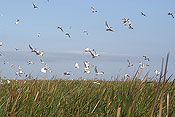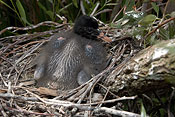
|
The Alley North Experience
|
|
Click on Images for Slideshow |
On the morning of March 30, 2005, I found myself on an airboat headed out several miles into the open sawgrass prairie of Water Conservation Area 3. I was in the company of two students and their research advisor. The two boats in front of us also carried people headed into the rookery to conduct research. The teams had all coordinated to go into the rookery together to minimize the amount of time that the birds and nests were disturbed. We had one hour to spend in the rookery known as Alley North.
Alley North is the largest rookery in the Everglades system by a long shot. In 2002, this one rookery contained more nests than the entire Everglades system had twenty years earlier. Most of the wading birds species that nest in the Everglades can be found in Alley North. Among the thousands of nests you can find hundreds of Great and Snowy Egrets, Tricolored, Little Blue, and Great Blue Herons as well as Black-crowned Night Herons, Glossy Ibis, Anhingas, and a handful of Roseate Spoonbills. However, of all the birds found in this rookery, White Ibis dominate them all. In 2002, there were just over 19,000 nests in the rookery and an estimated 16,000 of those nests were built and used by White Ibis.
I have experienced several smaller rookeries that have formed in zoos and other public attractions throughout the state where the birds were fully accustomed to human presence. The only time I had experienced a rookery in the wild was on a very small island on the west coast of Florida when I was a kid. My dad and I found a small mangrove island that was home to a couple dozen Green Heron nests and then a couple of years later it held a handful of Brown Pelican nests. I could not even fathom a colony that numbered near 20,000 nests.
After about a half hour of traveling through a maze of airboat trails, we arrived at a large tree island, also known as a willow head. As we pulled up, hundreds of adult White Ibis and herons took flight and circled overhead and then settled back down once the airboat propellers had been shut off. The tree island was dominated by small willow trees barely reaching ten feet in height surrounded by a marsh made up of primarily cattails with a few patches of sawgrass. The cattails reached about seven feet above the water making it extremely easy to get lost since there was no way to find a point of reference beyond the cattails that were right in front of your face. A few inches of water flooded the marsh while deeper pockets were up to a foot or more. Below the water was a deep layer of peat that formed from the years of dying grasses that were not able to decay and break down in the water. This rather spongy yet mucky bottom was fairly easy to walk on, as long as your foot didn’t go into someone else’s foot print and stick.
We had two different transects that needed to be counted so we split into two teams. My group prepared to get into the water to head into the rookery. The transect we were working on was known as “The Vines.” This transect wound through a portion of the willow dominated tree island with dozens of nests the researchers had marked earlier in the year. Every week or so, the researchers return to each transect and check the status of each of the marked nests. The status of these nests gives them a representative sample of the rest of the rookery and allows them to estimate the success of the entire rookery without having to continuously check, and disturb, every nest.
As we entered the water and headed into the rookery, I was told that this year had been a particularly bad year for the wading birds and that the researchers had been observing extremely high failure rates. Unusual dry season rains a few weeks before had raised the water level throughout much of the marsh, flooding some nests and dispersing the birds’ food sources making life difficult for birds that were attempting to feed chicks. As we entered the willows, we passed a number of nests that were only a few inches above the water at the base of cattails. All of these nests were empty or only contained a few broken egg shells. These egg shells were not left behind by newly hatched chicks but rather from vultures, crows, and other predators that had found the unprotected or abandoned nests.
As we started finding nests that were still occupied, we began to record data. Each nest was numbered and the number of eggs or number and size of chicks were recorded. We found one new nest that was quickly marked for observation on future trips. As we made our way through the rookery we found several White Ibis nests with one or two small black chicks that looked nothing like the adult birds. If it hadn’t been for the slightly curved bill, I never would have guessed that they were even Ibis. Among the Ibis nests we found one Great Egret nest with two fairly large chicks that threatened to jump out as I approached to photograph them. I quickly backed off so as not to cause these chicks to leap out of the nest. One small nest contained four light blue eggs. These eggs and the chicks in a nest a few meters away belonged to two pairs of Tricolored Herons, one of which was watching us keenly from a tree above. We had a one hour time limit in the rookery so I quickly got to work.
Many of the photographs I took were shot without my face to the camera. I found stretching my arm out away from my body was the best method of getting close to a nest while causing the least amount of disturbance. I photographed nests with chicks, nests with eggs, nests with broken eggs, empty nests, and the researchers working. The photographs I walked away with will never hang on someone’s wall. They are not the beautiful images of portraits of birds with nice clean backgrounds that I often strive to take. Instead, they tell a complex story of chaos and survival.
At a second site, composed of entirely cattails, we were attempting to set up a quadrant that could be surveyed from both the ground and the air. By counting the nests from the ground we could get a true count that could then be compared to the aerial count and an error could be calculated. At this site, there were only White Ibis nests and many of the nests had fairly large chicks in them. These chicks did not like our presence and many would jump out of their nests and run around in the marsh. The graduate student I was following at the time explained that most of these birds will be able to crawl back up into their nests since they are only a few inches or a foot off of the ground. Those that can’t will become a meal for something somewhere. Here we found several nests with dead babies and in some areas the water was littered with the bodies of dead chicks. As we were moving farther into the marsh we finally called off the plan because there were just too many young birds running around on the ground. It was not safe for the chicks and even if we did continue, the results would be inaccurate for two reasons. First, because the birds were out of the nests we could not get an accurate count of active nests during the ground count. Secondly, the adult birds would not be incubating the chicks full time so the aerial surveys would be inaccurate as well. So we abandoned our task and returned the airboats, a morning’s work complete.
During the half hour ride back to the boat ramp, I thought about the morning’s experience. I wanted to tell the story of the rookery and the struggle for life. I had my own struggles. I struggled with how to tell the story, how my own presence affected that struggle, how to capture what I saw and create successful and appealing images yet remain true to the subject. There are thousands of nests at this rookery. Of all of the thousands of eggs laid, only a small percentage of the chicks reach adulthood. Many fall victim to vultures and crows. Others become a meal for a snake or alligator or raccoon. Still more die of starvation as water levels rise and foraging becomes more difficult for the adult birds. And yet here we are, in the name of science, trying to understand our mistakes of the past and correct them for the future. Yet at the present, chicks are jumping out of nests and running through the marsh. Some will return to the nests, others won’t and will cement their fate by meeting an alligator or other predator. I am not trying to say we shouldn’t be there. I think that without this research some of these species, like the Wood Stork, would be long extinct. Research cannot be conducted without influencing the subject in someway. It is the ultimate irony of science.
Nature, like science and man, can be cruel and unforgiving. Yet at the same time, the miracle of life is ever-present in a rookery and brings hope that there will be another day for the species. Once again the skies will be filled and a new generation of elegant and graceful birds will bring smiles to the faces of children, parents, and grandparents alike.










